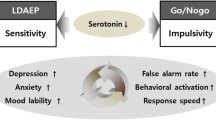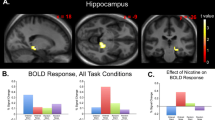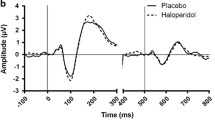Abstract
Rationale
The Loudness Dependence of the Auditory Evoked Potential (LDAEP) has been suggested as a reliable measure of central serotonin function in humans; however, its specificity for the serotonin system remains a topic of debate, with possible modulation of this purported serotonin marker by other neurotransmitters, including dopamine.
Objectives
We examined the effect of dopaminergic modulation on the LDAEP using the D1/D2/D3 dopamine receptor agonist pergolide and the D2/D3 agonist bromocriptine.
Methods
The study was a double-blind, placebo-controlled repeated-measures design in which healthy participants were tested under three acute treatment conditions: placebo, bromocriptine (2.5 mg), and pergolide (0.1 mg). Changes in the amplitude of the N1/P2 at intensities (60, 70, 80, 90, and 100 dB) were examined at C Z.
Results
Acute stimulation of D1/D2/D3 receptors with pergolide and D2/D3 receptors with bromocriptine in comparison with placebo had no effect on the LDAEP.
Conclusion
These findings indicate that acute stimulation of dopamine D1, D2, and D3 receptors does not modulate the LDAEP in humans. Although the findings suggest that the LDAEP may not be modulated by acute changes in dopamine neurotransmission, further studies are needed to fully characterize its dopaminergic sensitivity.


Similar content being viewed by others
References
Abduljawad KA, Langley RW, Bradshaw CM, Szabadi E (1999) Effects of bromocriptine and haloperidol on prepulse inhibition: comparison of the acoustic startle eyeblink response and the N1/P2 auditory-evoked response in man. J Psychoparmacol 13(1):3–9
Auerbach SB, Minzenberg MJ, Wilkinson LO (1989) Extracellular serotonin and 5-hydroxyindolacetic acid in hypothalamus of the anaesthetized rat measured by in vivo dialysis coupled to high performance liquid chromatography with electrochemical detection: Dialysate serotonin reflects neuronal release. Brain Res 499:281–290
Azmitia EC, Gannon PJ (1986) The primate serotonergic system: a review of human and animal studies and a report on Macaca fascicularis. Adv Neurol 43:407–468
Baribeau JC, Laurent J (1987) The effect of selective attention on augmenting/intensity function of the early negative waves of AEP’s. Electroencephalogr Clin Neurophysiol Suppl 40:68–75
Bartholomeusz CF, Box G, Van Rooy C, Nathan PJ (2003) The modulatory effects of dopamine D1 and D2 receptor function on object working memory in humans. J Psychopharmacol 17(1):9–15
Bruneau N, Barthelemy C, Jouve J, Lelord G (1986) Frontal auditory-evoked potential augmenting-reducing and urinary homovanillic acid. Neuropsychobiology 16:78–84
Carrillo-de-la-Pena MT (1999) Effects of intensity and order of stimuli presentation on AEP’s: an analysis of the consistency of EP augmenting/reducing in the auditory modality. Neurophysiol Clin 110:924–932
Charney D (1990) Serotonin specific drugs for anxiety and depressive disorder. Annu Rev Med 41:437–445
Cohen J (1992) A power primer. Psychol Bull 112:155–159
Connolly JF (1987) ERPs suggest the importance of subcortical mechanisms in activities typically associated with cortical functions. Electroencephalogr Clin Neurophysiol 40:635–644
Croft RJ, Barry RJ (2000) EOG correction of blinks with saccade coefficients: a test and revision of the aligned-artefact average solution. Neurophysiol Clin 111:444–451
Croft RJ, Klugman A, Baldeweg T, Gruzelier JH (2001) Electrophysiological evidence of serotonergic impairment in long-term MDMA (“Ecstasy”) users. Am J Psychiatry 158(10):1687–1692
Ferre S, Artigas F (1993) Dopamine D2 receptor-mediated regulation of serotonin extracellular concentration in the dorsal raphe nucleus of freely moving rats. J Neurochem 61(2):772–775
Frankle W, Laruelle M (2002) Neuroreceptor imaging in psychiatric disorders. Ann Nucl Med 16(7):437–446
Gallinat J, Bottlender R, Juckel G, Munke-Puchner A, Stotz G, Kuss HJ (2000) The loudness dependence of the auditory evoked N1/P2-component as a predictor of the acute SSRI response in depression. Psychopharmacology (Berl) 148:404–411
Gallinat J, Senkowski D, Wernicke C, Juckel G, Becker I, Sander T, Smolka M, Hegerl U, Rommelspacher H, Winterer G, Herrmann WM (2003) Allelic variants of the functional promoter polymorphism of the human serotonin transporter gene is associated with auditory cortical stimulus processing. Neuropsychopharmacology 28:530–532
Gibbs SE, D’Esposito M (2005) A functional MRI study of the effects of bromocriptine, a dopamine receptor agonist, on component processes of working memory. Psychopharmacology (Berl) 180(4):644–653
Hegerl U, Juckel G (1993) Intensity dependence of auditory evoked potentials as an indicator of central serotonergic neurotransmission: a new hypothesis. Biol Psychiatry 33:173–187
Hegerl U, Bottlender R, Gallinat J, Kuss HJ, Ackenheil M, Moller HJ (1998) The serotonin syndrome scale: first results on validity. Eur Arch Psychiatry Clin Neurosci 248:96–103
Heninger GR, Delgado PL, Charney DS (1996) The revised monoamine theory of depression: a modulatory role for monoamines based on new findings from monoamine depletion experiments in humans. Pharmacopsychiatry 29:2–11
Juckel G, Molnar M, Hegerl U, Csepe V, Karmos G (1997) Auditory evoked potentials as indicator of brain serotonergic activity—first evidence in behaving cats. Biol Psychiatry 41:1181–1195
Juckel G, Hegerl U, Molnar M, Csepe V, Karmos G (1999) Auditory evoked potentials reflect serotonergic neuronal activity—a study in behaving cats administered drugs acting on 5-HT1A autoreceptors acting in the dorsal raphe nucleus. Neuropsychopharmacology 21:710–716
Juckel G, Gallinat J, Riedel M, Sokullu S, Schulz C, Hans-Jurgen M, Muller R, Hegerl U (2003) Serotonergic dysfunction in schizophrenia assessed by the loudness dependence measure of primary auditory cortex evoked activity. Schizophr Res 64:115–124
Kuhn R (1957) Uber Die Behandlung Depressives Zustande Mit Einem Iminobenzylderivat (G 22,355). Schweiz Med Wochenschr 87:1135–1140
Lee TW, Yu YW, Chen TJ, Tsai SJ (2005) Loudness dependence of the auditory evoked potential and response to antidepressants in Chinese patients with major depression. J Psychiatry Neurosci 30(3):202–205
Lewis DA, Campbell MJ, Foote SL, Morrison JH (1986) The monoaminergic innervation of primate neocortex. Hum Neurobiol 5(3):181–188
Luciana M, Depue RA, Arbisi P, Leon A (1992) Facilitation of working memory in humans by a D2 dopamine receptor agonist. J Cogn Neurosci 4:58–68
Markham A, Benfield P (1997) Pergolide: a review of its pharmacology and therapeutic use in Parkinson’s disease. CNS Drugs 7 (4):328–340
Martin-Ruiz R, Ugedo L, Honrubia MA, Mengod G, Artigas F (2001) Control of serotonergic neurons in rat brain by dopaminergic receptors outside the dorsal raphe nucleus. J Neurochem 77(3):762–775
Morrison J, Foote SL, Molliver ME, Bloome FE, Lidov HGW (1982) Noradrenergic and serotonergic fibres innervate complementary layers in monkey primary visual cortex: an immunohistochemical study. Proc Natl Acad Sci U S A 79:2401–2405
Muller U, von Cramon DY, Pollman S (1998) D1- vs D2-receptor modulation of visuospatial working memory in humans. J Neurosci 18:2720–2728
Murphy D (1990) Peripheral indices of central serotonin function in human. Ann N Y Acad Sci 600:282–296
Nathan PJ, O’Neill B, Croft RJ (2005) Is the loudness dependence of the auditory evoked potential a sensitive and selective in vivo marker of central serotonergic function? Neuropsychopharmacology 30(8):1584–1585; author reply 1586–1587
Nathan PJ, Segrave R, Phan KL, O’Neill B, Croft RJ (2006) Direct evidence that acutely enhancing serotonin with the selective serotonin reuptake inhibitor citalopram modulates the loudness dependence of auditory evoked potential (LDAEP) marker of central serotonin function. Hum Psychopharmacol 21(1):47–52
Oranje B, Gispen-de Wied CC, Westenberg HG, Kemner C, Verbaten MN, Kahn RS (2004) Increasing dopaminergic activity: effects of L-dopa and bromocriptine on human sensory gating. J Psychopharmacol 18 (3):388–394
Perachon S, Schwartz JC, Sokoloff P (1999) Functional potencies of new antiparkinsonian drugs at recombinant human dopamine D1, D2 and D3 receptors. Eur J Pharmacol 366 (2–3):293–300
Pogarell O, Tatsch K, Juckel G, Hamann C, Mulert C, Popperl G, Folkerts M, Chouker M, Riedel M, Zaudig M, Moller HJ, Hegerl U (2004) Serotonin and dopamine transporter availabilities correlate with the loudness dependence of auditory evoked potentials in patients with obsessive–compulsive disorder. Neuropsychopharmacology 29(10):1910–1917
Raine A, Mitchell DA, Venables PH (1981) Cortical augmenting-reducing—modality specific? Psychophysiology 18(6):700–708
Sargent PA, Kjaer KH, Bench CJ, Rabiner EA, Messa C, Meyer J, Gunn RN, Grasby PM, Cowen PJ (2000) Brain serotonin1A receptor binding measured by positron emission tomography with [11C]WAY-100635: effects of depression and antidepressant treatment. Arch Gen Psychiatry 57(2):174–180
Seamans JK, Yang CR (2004) The principal features and mechanisms of dopamine modulation in the prefrontal cortex. Prog Neurobiol 74(1):1–58
Senkowski D, Linden M, Zubragel D, Bar T, Gallinat J (2003) Evidence for disturbed cortical signal processing and altered serotonergic neurotransmission in generalized anxiety disorder. Biol Psychiatry 53:304–314
Simmons JG, Allen NB, Berger G, Nathan PJ (2003) The influence of chronic sertraline administration on the loudness dependence of the auditory evoked potential in healthy subjects. Psychophysiology 40:S80
Simpson GV, Knight RT (1993) Multiple brain systems generating the rat auditory evoked potential. I. Characterization of the auditory cortex response. Brain Res 602:240–250
Strobel A, Debener S, Schmidt D, Hunnerkopf R, Lesch KP, Brocke B (2003) Allelic variation in serotonin transporter function associated with the intensity dependence of the auditory evoked potential. Am J Med Genet 118B:41–47
Trantham-Davidson H, Neely LC, Lavin A, Seamans JK (2004). Mechanisms underlying differential D1 versus D2 dopamine receptor regulation of inhibition in prefrontal cortex. J Neurosci 24:10652–10659
Tuchtenhagen F, Daumann J, Norra C, Gobbelé R, Becker S, Pelz S, Sass H, Buchner H, Gouzoulis-Mayfrank E (2000) High intensity dependence of auditory evoked dipole source activity indicates decreased serotonergic activity in abstinent ecstasy (MDMA) users. Neuropsychopharmacology 22:608–617
Von Knorring L, Perris C (1981) Biochemistry of the augmenting/reducing response in visual evoked potentials. Neuropsychobiology 7:1–8
Zemon V, Kaplan E, Ratliff F (1986) The role of GABA-mediated intracortical inhibition in the generation of visual evoked potentials. In: Cracco RQ, Bodis-Wollner I (eds) Evoked potentials. Liss, New York, pp 287–295
Acknowledgement
The study was supported by a grant to P.J.N. from the National Health and Medical Research Council (NHMRC) of Australia (grant no. 345709). Participant medical examinations were conducted by Susan Illic, M.D.
Author information
Authors and Affiliations
Corresponding author
Rights and permissions
About this article
Cite this article
O’Neill, B.V., Croft, R.J., Leung, S. et al. Dopamine receptor stimulation does not modulate the loudness dependence of the auditory evoked potential in humans. Psychopharmacology 188, 92–99 (2006). https://doi.org/10.1007/s00213-006-0501-5
Received:
Accepted:
Published:
Issue Date:
DOI: https://doi.org/10.1007/s00213-006-0501-5




